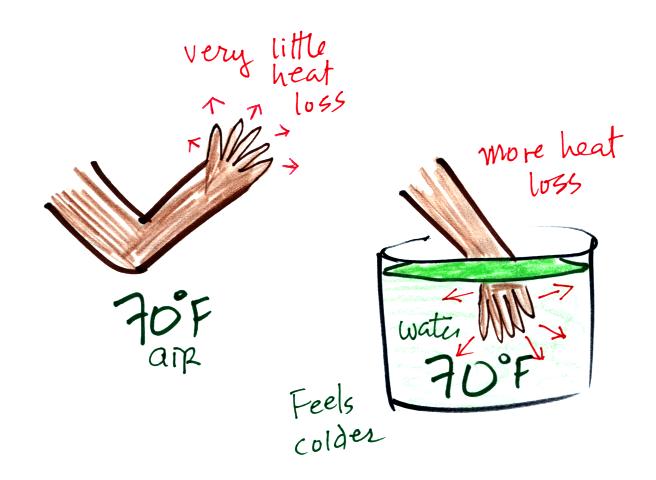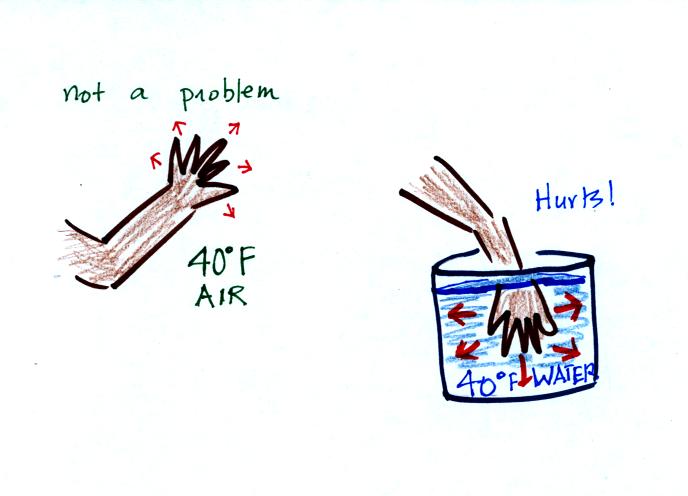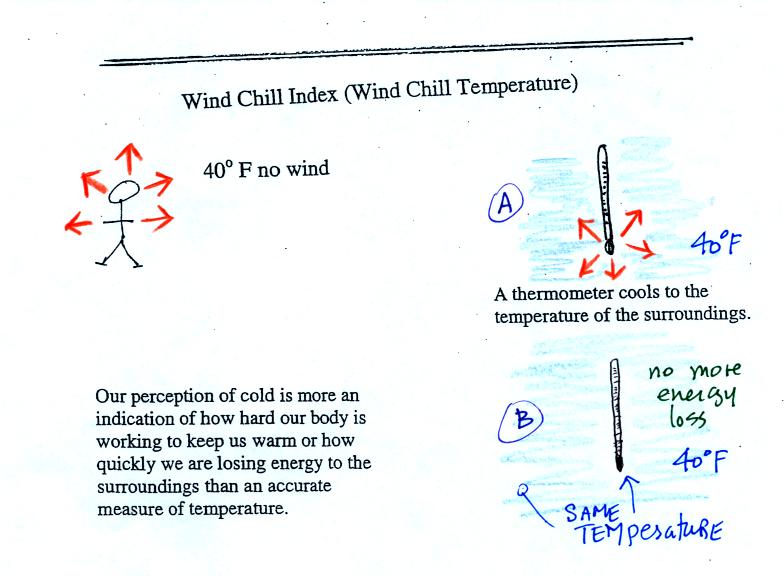The thin tubes are all filled with
water. The teepee like structure stays warm because of water's
high specific heat. Nighttime temperatures can drop into the 20s
and the tomato inside will be protected.
Because
air has such a low thermal conductivity it is often used as an
insulator. It is important, however, to keep the air trapped in
small pockets or small volumes so that it isn't able to move and
transport energy by convection (we'll look at convection
shortly). Here are some examples of
insulators that use air:
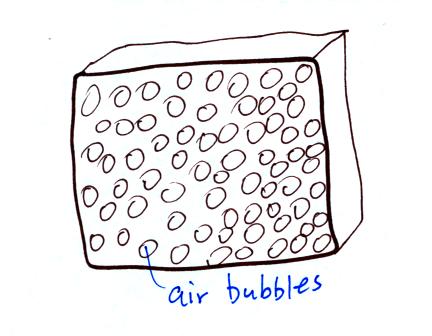 Foam is filled with lots of small air bubbles
Foam is filled with lots of small air bubbles
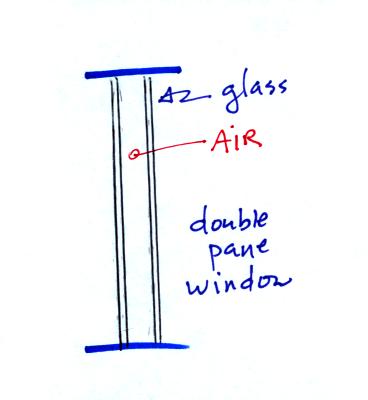 Thin insulating layer of air in a double
pane window
Thin insulating layer of air in a double
pane window
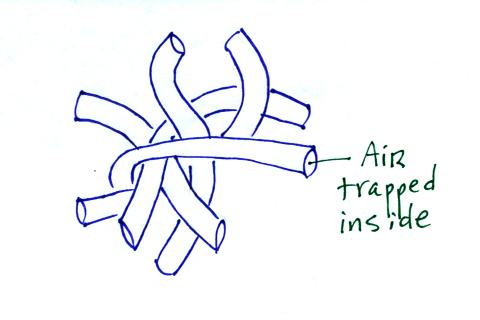 Hollow fibers (Hollofil) filled with air used in
sleeping
bags and
winter coats. Goose down works in a similar way.
Hollow fibers (Hollofil) filled with air used in
sleeping
bags and
winter coats. Goose down works in a similar way.
Convection
was the next energy transport process we had a look at. Rather
than moving about randomly, the atoms or molecules move as a
group. Convection works in liquids and gases but not
solids.
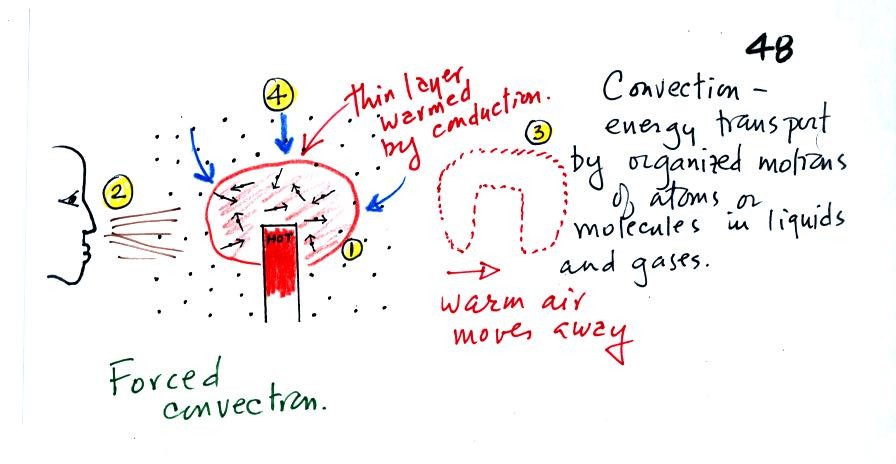
At Point 1 in the picture above a
thin layer of air
surrounding a hot object has
been
heated by conduction. Then at Point 2 a person (yes, that is a drawing
of a
person's head) is blowing the blob of warm air
off to the right. The warm air molecules are moving away at Point
3 from the
hot object together as a group (that's the organized part of the
motion). At Point 4 cooler air moves in and surrounds the hot
object and the whole process can repeat itself.
This is forced
convection. If you have a hot object in your hand you could just
hold onto it and let it cool by conduction. That might take a
while because air is a poor conductor. Or you could blow on the
hot object and force it to cool more quickly. If I had put a
small fan behind the curry powder demonstration the other day it would
probably have
spread the
smell faster and further out into the classroom.
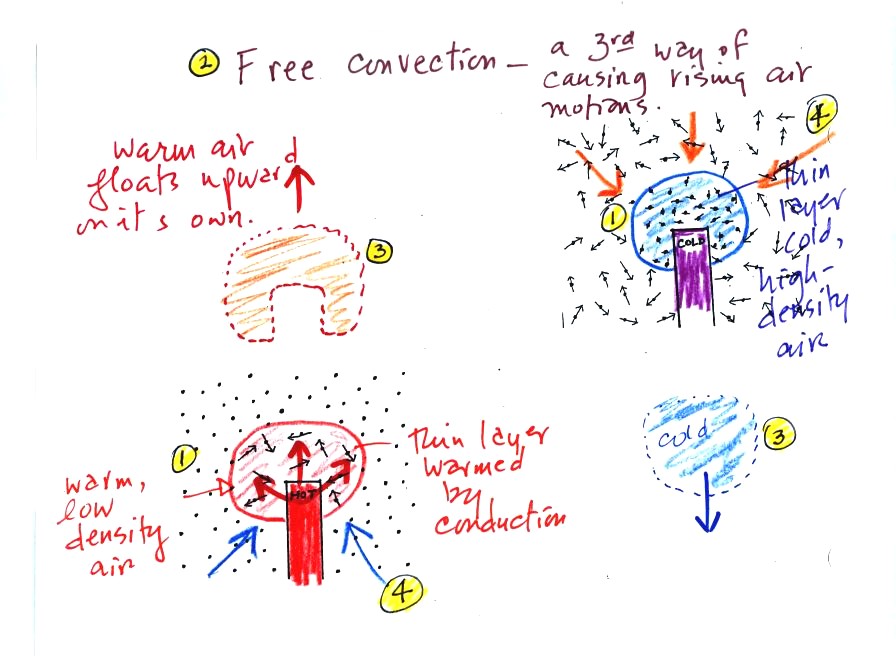
A thin layer of air at Point 1 in
the figure above (lower
left) is
heated by conduction. Then because hot air is also
low density air, it actually isn't necessary to blow on the hot object,
the
warm air will rise by itself (Point 3). Energy is being
transported away
from the hot object into the cooler surrounding air. This is
called free convection and
represents another way of causing rising air motions in the atmosphere
(rising air motions are important because rising air expands as it
moves into lower pressure surroundings and cools. If the air is
moist, clouds can form). Cooler air moves in to take the place of
the rising air at Point 4 and the cycle repeats itself.
The example at upper right is also
free convection. Room temperature air in contact with a cold
object loses energy and becomes cold high density air. The
sinking
air motions that would be found around a cold object have the effect of
transporting energy from the room temperature surroundings to the
colder object.
In both examples of free convection, energy is being transported
from
hot toward cold.
Now some
practical applications of what we have learned about conductive and
convective energy transport. Energy transport really does show up
in a lot more everyday real life situations than you might expect.
Note first of all there is a temperature difference between
your hand and a 70 F object. Energy will flow from your warm
hand to the colder object. Metals are better conductors than
wood. If you touch a
piece of
70 F metal it will feel much colder than a piece of 70 F wood, even
though they both have the same temperature. A piece of wood and a
piece of aluminum were passed around class so ou could check this
out for yourself. A
piece
of 70 F diamond would feel even colder because it is an even better
conductor
than metal.
Something that feels cold may not be as
cold as it seems. Our perception of cold is more an
indication of how
quickly our hand is losing energy than a reliable measurement of
temperature.
Here's a similar situation.
It's pleasant standing outside on a nice day like this in 70 F air
(that's what many of your fellow students are doing instead of sitting
in class). But if you jump into 70 F pool water you
will
feel cold, at least until you "get used" to the water temperature (your
body might reduce blood flow to your extremeties and skin to try to
reduce energy loss).
Air is a poor conductor. If you go out in
40 F
weather you will feel colder largely because there is a larger
temperature difference between you and your surroundings (and
temperature difference is one of the factors that affect rate of energy
transport by conduction).
If you stick your hand
into a bucket of 40 F water (I would suggest you give it a try
sometime), it will feel very cold (your hand will
actually soon begin to hurt). Water is a much better conductor
than air. Energy flows much more rapidly from your hand into the
cold water.
The next 2 figures weren't shown
in class.
Ice
feels cold even though it is not a particularly good
conductor. This is because of the large temperature difference
between your hand and the water.

What about liquid nitrogen? It has a temperature of
-320F! You can safely stick your
hand in liquid nitrogen for a fraction of a second. It doesn't
feel particularly cold and doesn't feel wet. Some of the liquid
nitrogen quickly evaporates and surrounds your hand with a layer of
nitrogen
gas. This gas is a poor conductor and momentarily insulates your
hand from the cold.
Now we're
in a perfect position to understand wind chill.
If you go outside on a 40 F day (calm winds) you will
feel
cool; your
body is losing energy to the colder surroundings (by conduction
mainly). Your body works hard to keep its core temperature around
98.6 F. A thermometer
behaves differently. It actually cools to the temperature of the
surroundings. Once it reaches 40 F it won't lose any additional
energy.
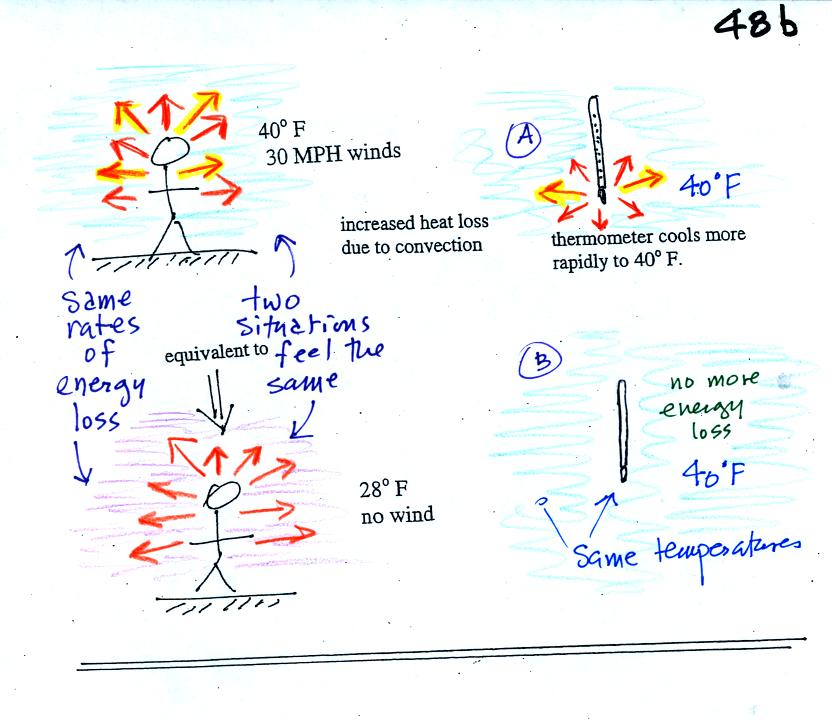
Actually, in terms of the rate at which your
body loses energy, the windy 40 F day would feel the same as a calm 28
F day. Your body is losing energy at the same rate in both
cases. The combination 40 F and 30 MPH winds results in a wind
chill temperature of 28 F.
The thermometer will again cool to the
temperature of its surroundings, it will just cool more quickly on a
windy day. Once the thermometer reaches 40 F there won't be any
additional energy flow. The
thermometer would measure 40 F on both the calm and the windy day.
Standing outside on a 40 F day is usually not a life threatening
situation. Falling into 40 F water is.
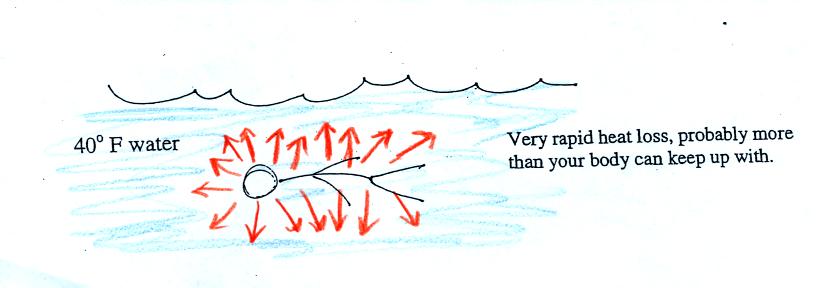 Energy will be conducted away from your body more quickly than
your
body can replace it. Your core body temperature will drop and
bring on hypothermia.
Be sure not to confuse hypothermia with hyperthermia which
can bring on
heatstroke and which is also a serious outdoors risk in S.
Arizona.
Energy will be conducted away from your body more quickly than
your
body can replace it. Your core body temperature will drop and
bring on hypothermia.
Be sure not to confuse hypothermia with hyperthermia which
can bring on
heatstroke and which is also a serious outdoors risk in S.
Arizona.
At this
point I showed a
picture from the March 2005 issue of National Geographic. A Buddhist
monk was standing in a frigid waterfall. The caption for the
photograph read "To focus the mind and increase awareness of self,
Shingon Buddhists like Souei Sakamoto practice takigyo,chanting
for hours while standing in frigid waterfalls at the Oiwasan Nissekiji
Temple in Toyama, Japan." (I can't really scan the photograph and
include it in the classnotes because of copyright laws)
A second photograph from the December 2005 issue showed a monk hanging
from a tree by his feet. The caption there read "To
see life as it truly is - that's the goal of a student in China who
strengthens mind and body under the rigorous tutelage of a Shaolin kung
fu master."
Perhaps the most amazing example of a physical and mental task is the
1000-day challenge undertaken by the "marathon
monks" of Mount Hiei, Japan.
I hope you don't mind an
occasional digression like this. I spend a lot of time
riding my bicycle
uphills. It's not really painful but can definitely be
uncomfortable. I've
noticed that you can sometimes be distracted by a thought and ride a
mile or so and completely blank out the discomfort. With some
"Buddhist monk like" training I wonder if maybe I couldn't ride uphill
more or less indefinitely and not feel any discomfort at all.
This time of the year it is often a little cool in the morning.
With some mental training I hope be to be able to blank the feeling of
cold. Both are things I'll continue to work on.
Latent
heat energy transport was the final topic of the day.
Energy
transport in the form of latent heat is the second most important
energy transport process (second only to electromagnetic
radiation). A copper bar was heated earlier in class with a
propane torch. How could you quickly cool the bar
off. The first and probably the best suggestion was to stick it
into some water. The water would conduct away heat but you would
probably also hear a "pssst" when you first stuck the bar in the
water. That would be the sound of boiling
(evaporating) water. A phase change like that would take a lot of
energy from the bar and would probably cool the bar in a few seconds.
Latent heat energy transport is sometimes a little hard to visualize
or understand because the energy is "hidden" in water vapor or water.
Latent heat energy transport is
associated with changes of
phase (solid to liquid, water to water vapor, that sort of thing) A
solid to liquid phase change is melting, liquid to gas is
evaporation, and sublimation is a solid to gas phase change (dry ice
sublimates when placed in a warm room, it turns directly from solid
carbon dioxide to gaseous carbon dioxide).
In
each case energy must be added to the material changing phase.
You can consciously add or supply the energy (such as when you put
water in a
pan and put the pan on a hot stove) or the needed energy will be
taken from the surroundings (from your body when you step out of a
shower in the morning).

When
your body starts to lose energy, it feels cold.
A 240 pound man or woman running at 20 MPH has just
enough
kinetic energy (if you could capture it) to
be able to melt an ordinary ice cube. It would take 8 people
running at 20 MPH to
evaporate the resulting water.






